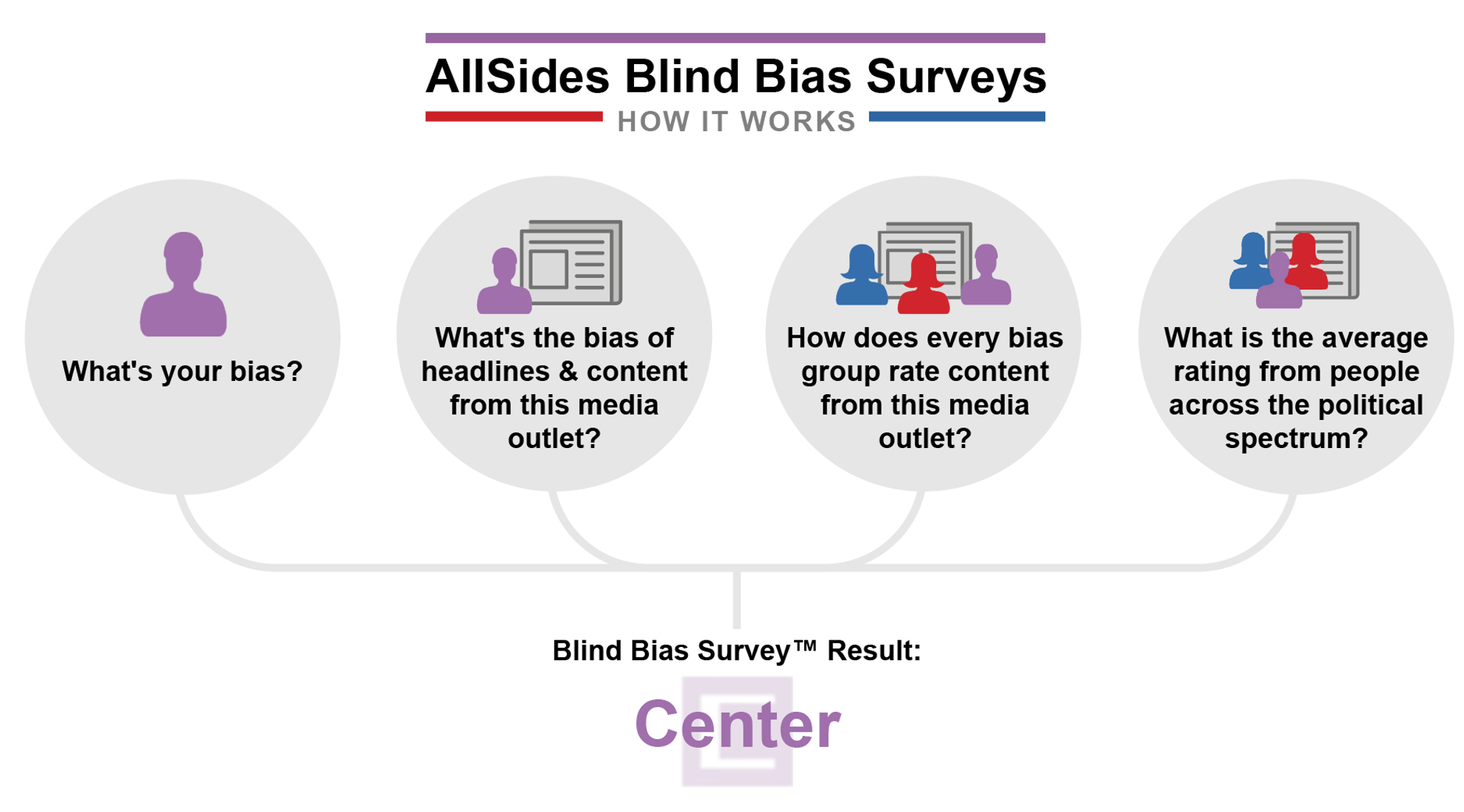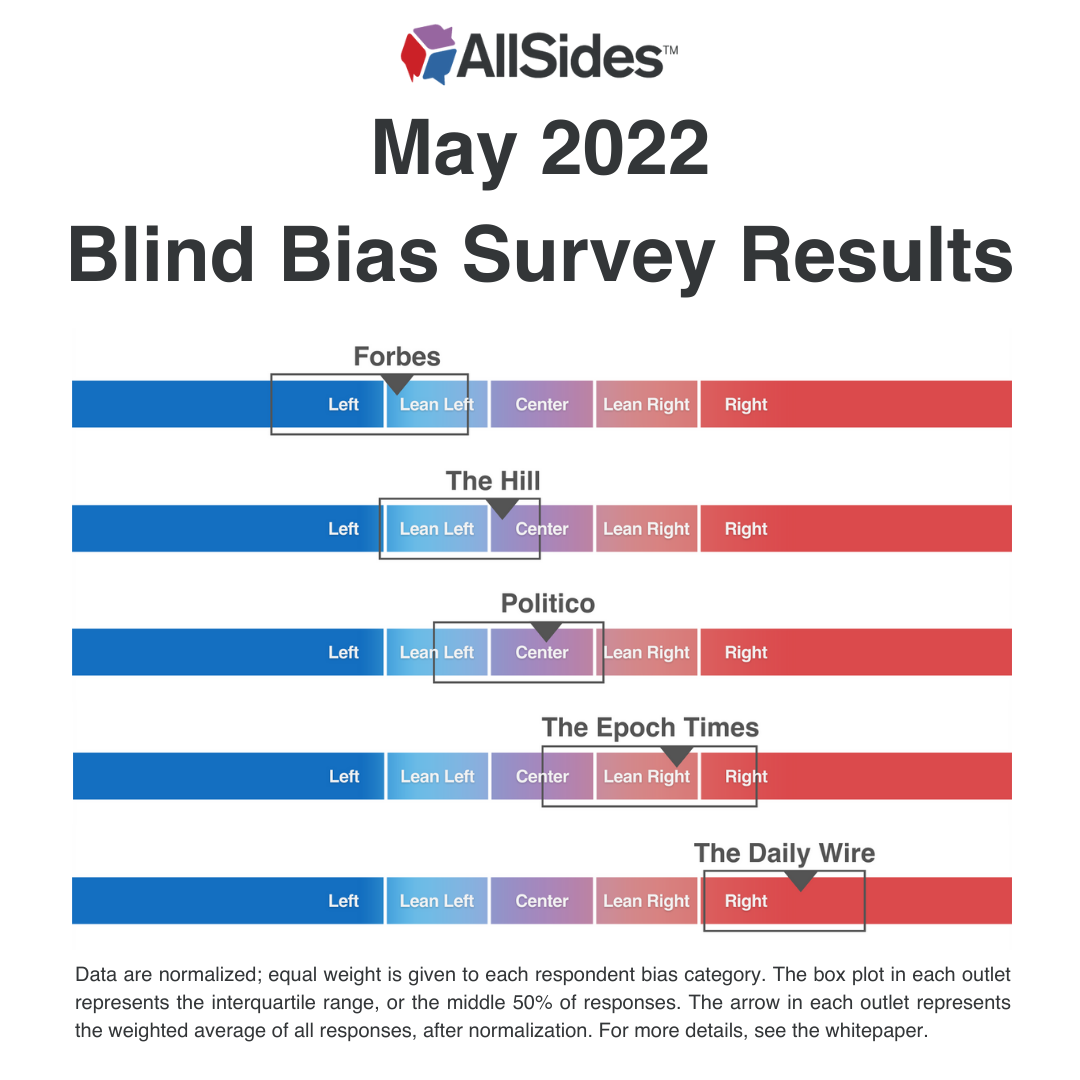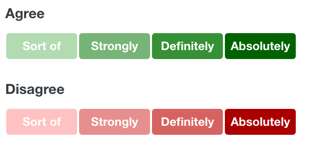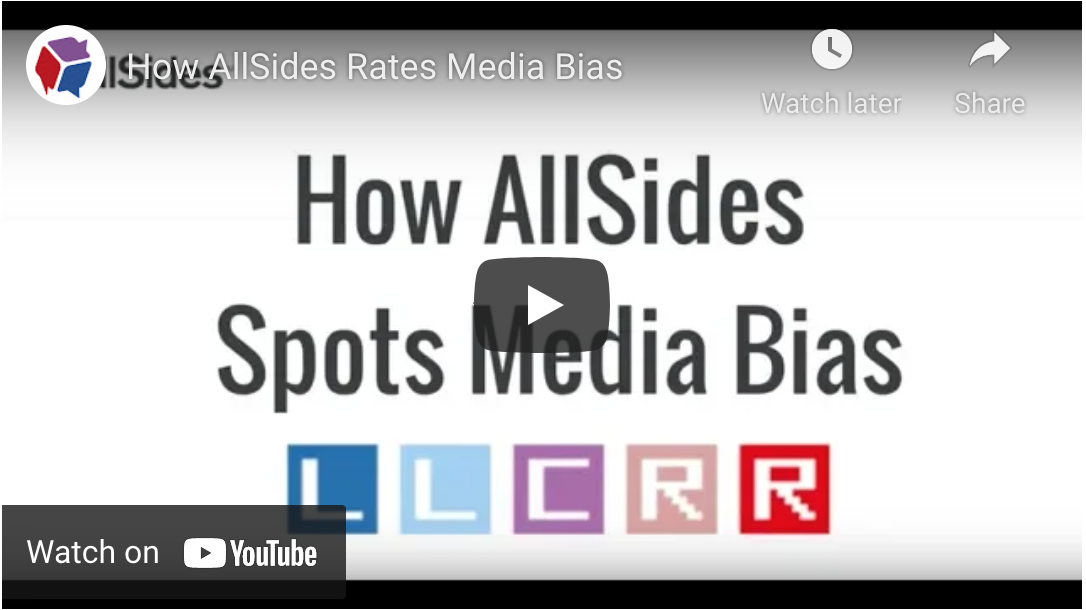AllSides Media Bias Ratings™ reflect the average judgment of all Americans, not just a panel of insiders.
AllSides balances the input of experts and ordinary people across the political spectrum so that our bias ratings reveal the average judgment of all Americans, not one elite group. We use multi-partisan Editorial Reviews by trained experts and Blind Bias Surveys™ in which participants rate content without knowing the source.
Our patented media bias ratings system drives what is arguably the world's most trustworthy media bias ratings. On the media bias rating page for any given source, you'll see the methods we used listed with a check mark next to them. Learn more about each of our methods below.
About AllSides Media Bias Ratings™
AllSides assigns a rating of Left, Lean Left, Center, Lean Right, or Right to each media outlet or writer, as well as a numerical rating on the AllSides Media Bias Meter™.

The AllSides Media Bias Meter™ adds nuance to our categorical Left, Lean Left, Center, Lean Right, and Right bias ratings. Each media outlet receives an overall rating in one of these categories, and they are also assigned a numerical rating that is based on a scale of -6 to +6, with 0.0 representing exact Center, and -6 representing farthest Left, and +6 representing farthest right.
The AllSides Media Bias Meter is especially helpful for conveying when an outlet is on the borderline of two ratings — for instance, many modern news outlets fall on the border of the Center and Lean Left categories. The numerical rating categories are as follows: Left: -6.00 to -3.00, Lean Left: -2.99 to -1.00, Center: -0.99 to +0.99, Lean Right: +1.00 to +2.99, and Right: +3.00 to +6.00.
Our Methods
Watch a 2-minute overview of our methods.
✔ Editorial Review
AllSides Editorial Reviews are conducted by a multipartisan panel of six to nine reviewers from the left, center, and right who review news reports, look for indicators of bias, discuss findings, and issue a bias rating.
The panel looks for common types of media bias such as slant, spin, sensationalism, and story choice. We review the outlet’s homepage, headlines, recent articles, photos, and other content dating as far back as six months using online archival tools like the Wayback Machine. Taking into account all perspectives, panelists individually assign a number, between -6.0 and +6.0, that they believe best represents the bias of the media outlet. These numerical ratings are then transcribed into a weighted average.
Editorial Reviews are designed to be multipartisan. Because bias is in the eye of the beholder, each reviewer has a subjective opinion on the source's bias. Often there is broad agreement; other times, reviewers share evidence and deliberate.
In addition to full Editorial Reviews, we sometimes conduct Small Group Editorial Reviews, in which a smaller, three-person panel — one person each from the left, center, and right — reviews an outlet for bias.
Learn more about AllSides Editorial Reviews
See recent Editorial Reviews
✔ Blind Bias Survey
In a Blind Bias Survey, average Americans across the political spectrum read headlines and articles from a media outlet and provide an overall bias rating for the source, without knowing what source they are rating.
Blind Bias Surveys factor in the following:
- The political leaning of each survey participant.
- How each participant rates the bias of headlines and content from the media outlet.
- How participants with different biases (aka "Bias Groups") rate the content differently.
- The average rating from each Bias Group.
- The average rating from all participants across the political spectrum.

We remove all branding and identifying information from the news reports so respondents are not influenced by preconceived notions of an outlet’s bias. We then look at how every Bias Group (people who self-identify as Left, Lean Left, Center, Lean Right or Right using our Rate Your Bias Tool) rated the source’s reporting on average. We then calculate an average bias rating across all groups.
Blind Bias Surveys are one of our most robust rating methods, but they do have limitations. Respondents assess a relatively small snapshot of the source's content in time, and the surveys don't include photos or other visual elements. This is why we use multiple methods to rate bias, and often pair Blind Bias Surveys with Editorial Reviews.
Below are the results from our May 2022 Blind Bias Survey. View the full report here.

Participate in our next Blind Bias Survey
See recent Blind Bias Surveys
✔ Independent Review
An Independent Review is when an AllSides reviewer assesses content from a source and comes to a general conclusion on its bias. This is our lowest level of analysis.
The reviewer looks for common types of media bias, determines whether the outlet is transparent about its bias, and reviews any reports about the source’s political leanings. This method is typically used to provide an initial bias rating before more robust methods can be applied, or when the bias of an outlet is relatively easy to discern because the outlet is transparent about its political leaning.
See recent Independent Reviews
✔ Third-Party Data
We sometimes take into consideration academic research, surveys, or analysis from third parties that are transparent about their system for determining bias. AllSides always notes which analyses it has taken to account on the source page for any outlet.
✔ Community Feedback
You can vote on whether or not you agree with our ratings, but our ratings are not determined by community votes or majority rule. Community feedback is valuable because it acts as a warning sign that our current bias rating may be off, triggering deeper review.
This feedback is not blind. When people rate sources, they can see which source they are rating, how AllSides has previously rated the source, which bias review methods AllSides has applied, and how other people have voted. Since voting is not blind, it is subject to bias itself, as users are influenced by their preconceived notions of the media outlet or other people’s opinions.
Community feedback is not normalized. In other words, the raw data has not been balanced to fairly represent the various segments and groups in America. For example, if 100% of the people who rated a source were liberal, the media bias ratings they give would be very biased toward the left, and not representative of America overall. For example, a news outlet that Americans on average consider to be Left might instead be rated by the liberal group as Center, because the source closely reflects their own views, which they perceive as in the middle.
If a lot of people disagree with one of our bias ratings, it does not prompt us to outright change the bias rating, but rather, may trigger us to conduct more robust blind surveys, editorial reviews, or other kinds of research to sharpen the bias rating.
AllSides shows raw votes by our users, with the first number representing the people who agree with our bias rating, and the second number represent those who disagree. We color code these for easy reference:

It is not unusual for more than half of people to say they disagree with an AllSides Media Bias Rating, but the average rating they provide for the source is often in line with the AllSides Media Bias Rating. For example, AllSides may have rated a source as “Lean Left,” and the majority of voters say they disagree with that rating. But more than half will say they believe that source is “Left,” and the rest will rate it as “Center” or “Lean Right." That means the average will equal “Lean Left," thus supporting the original AllSides Media Bias Rating. See notes for each source for more details.
Sometimes, you will see a media bias rating to the right of this community feedback indicator. This is the average rating of people who disagreed with the AllSides media bias ratings and who bothered to also submit what they think the rating is (many disagree but do not rate themselves). It is not the average rating of the community at large since it does not include those who agree with the AllSides rating, those who disagree but did not rate, and is not normalized to reflect all of America (so one group can easily be over-represented, skewing the results.)
Vote on our Media Bias Ratings
Confidence Level
We rate our confidence in any given rating as Low or Initial, Medium, or High. Our confidence level is based on two things:
- How many methods have been applied, and which ones. The more methods that have been applied, the more confident we are in a rating. For example, we have more confidence in a rating for a source that has undergone both a Blind Bias Survey and an Editorial Review than one that has only undergone an Independent Review.
- The strength and consistency of the data. The stronger and more consistent the data is, the higher our Confidence Level. For example, if an outlet self-describes as “conservative,” that is a strong indication our rating is on target. Or, if an Editorial Review indicated a source was Right, but a Blind Survey returned a Lean Right rating, the inconsistency means our Confidence Level is lower. Or, if we are taking academic Third Party Data into consideration, but the research is 20 years old, our confidence level is lower since the data is so old.
How You Can Participate
We are constantly evolving the media bias rating engine. The more you participate, the better our media bias ratings will be, and the more sources we can rate.
- Discover your own bias. Make the world a better place by understanding and sharing your own bias openly! Use our bias rating tool to clarify how you judge your own bias.
- Participate in our next Blind Bias Survey. By participating in our online research, you'll be helping AllSides to make media bias transparent and help people to identify diverse perspectives — creating a stronger society as a result. Sign up to participate.
- Vote on the Media Bias Ratings. Search through our full list of ratings and let us know where you agree or disagree.
- Consume a balanced news diet. Our ratings drive our newsfeed, where we display the day’s top news stories from the Left, Center and Right of the political spectrum — side-by-side so you can see the full picture. Read our Balanced Newsfeed.
- Use the ratings in your research or product. AllSides Media Bias Ratings™ are licensed under a Creative Commons BY-NC 4.0 License, which means may be used for research or noncommercial purposes with attribution. Commercial use is permissable with a license agreement. To request this data as a CSV or JSON file, contact us.


